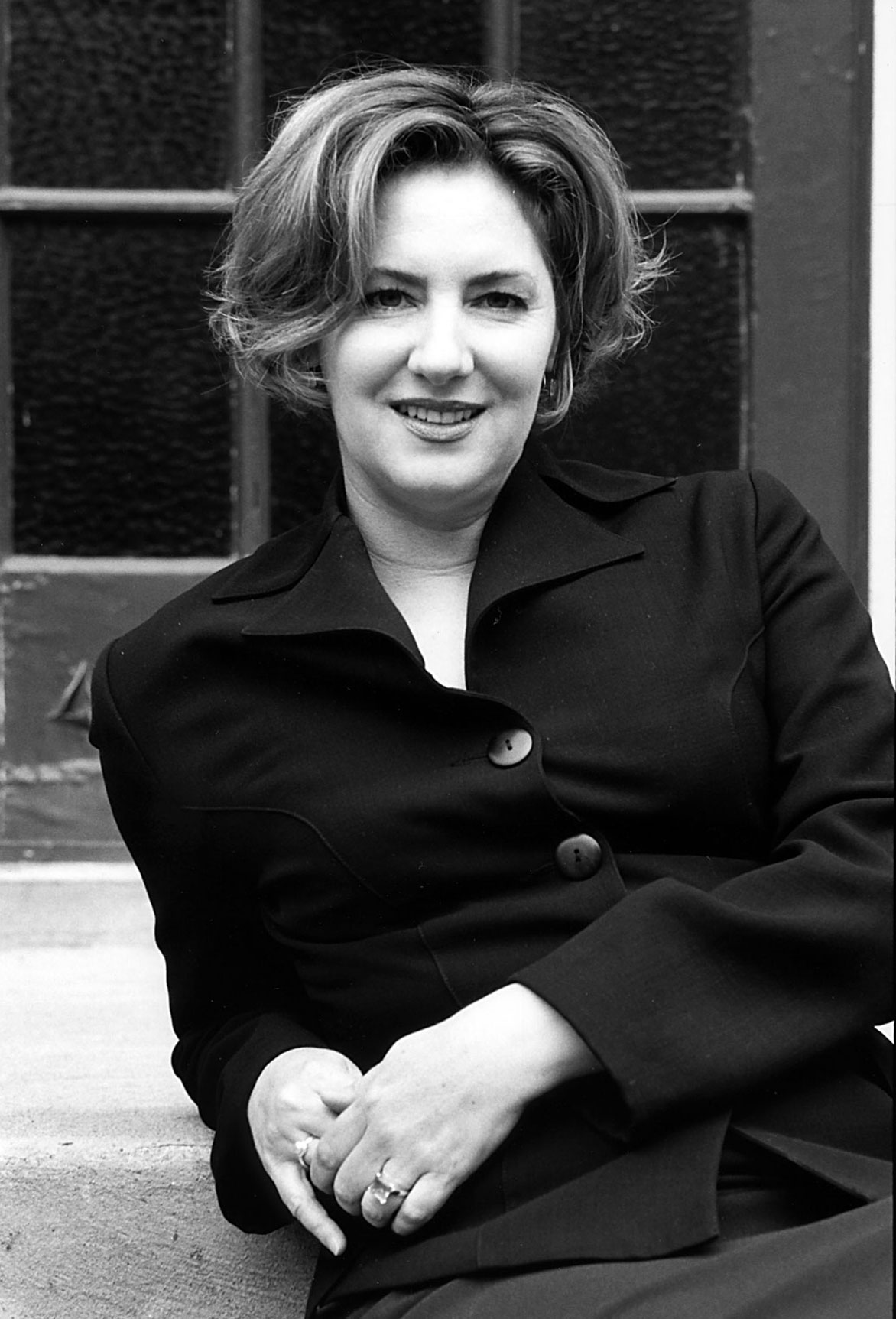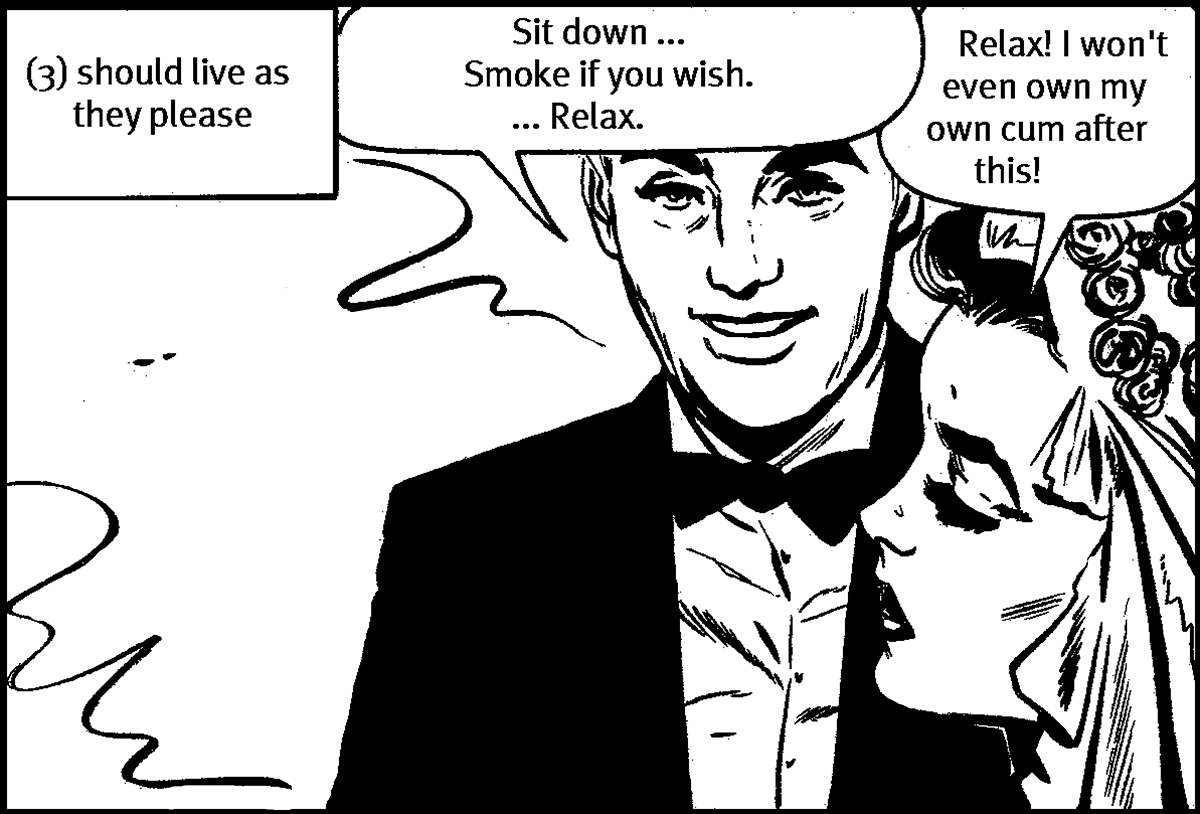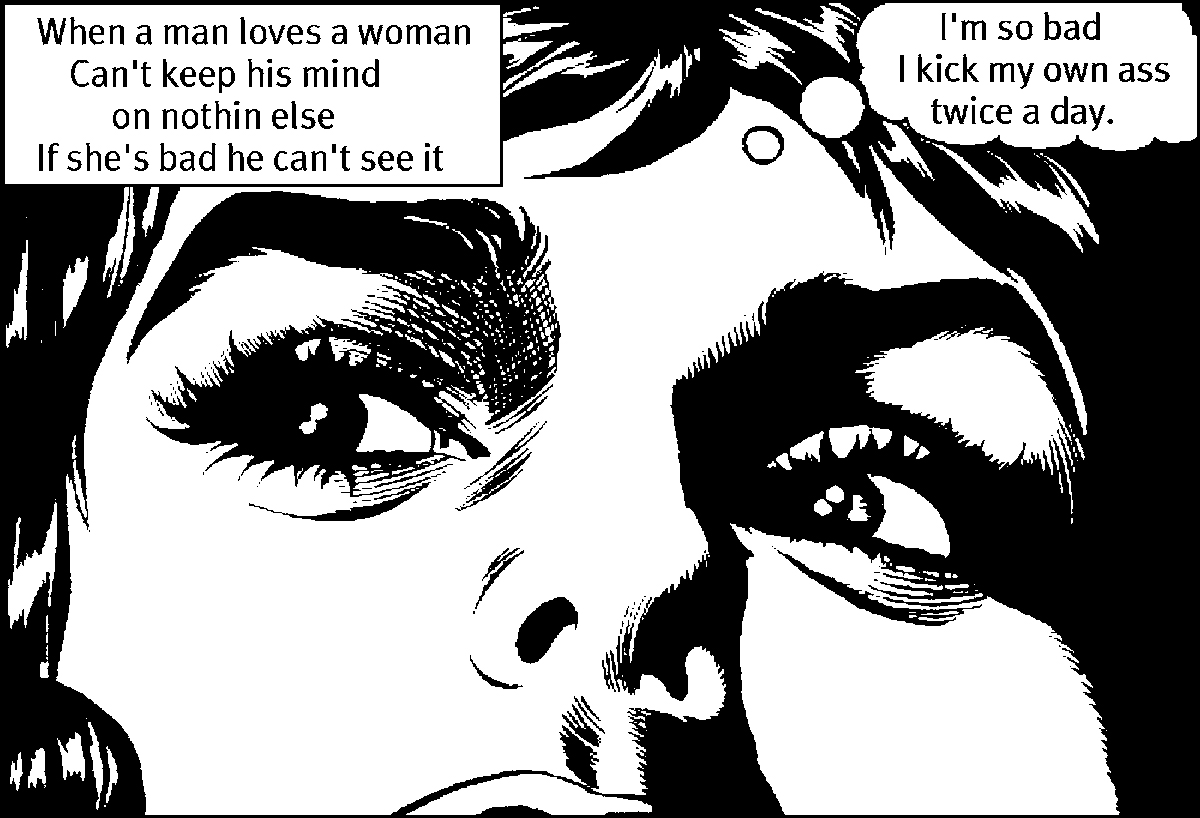
“My book made someone dance. That makes me so happy!”
I have just finished telling Patricia Seaman that there had been some dancing in my household when quotes from the song “Love Potion No. 9” popped up in the text of her latest work, the graphic novel New Motor Queen City.
Seaman laughs easily and heartily, especially when discussing her book, a small paperback filled with images culled from Mexican romance comics and over-laid with song lyrics, pop-culture references and quotes taken everywhere from Chinese restaurant placemats to Kathy Acker books.
Though not a household name, Seaman does have a following, thanks to her critically well-received collection of short stories, 1994’s The Black Diamond Ring, and her 1989 novella, Hotel Destiné. New Motor Queen City isn’t Seaman’s first graphic work—several years ago she self-published a few artists’ books and comics which, as she puts it, “no one has seen” due to their low print run of about fifty.
Moving from novels and short stories to comics may seem an unlikely thing to do, but given that Seaman has a background in visual art and design (as does most of her family), it isn’t unexpected. In fact, Seaman says a careful attention to language (she also holds a degree in English literature) links her various forms of artwork. “I really, really love language. I care about language,” she says. “I’m really interested in vernacular. I think there is a huge hierarchy attached to vernacular and I wanted to take the lowest, most pathetic, most devalued words and, by changing the context, give them more value. The word ‘underpants’ has the worst rap in the world, and I just love to use it. It’s my favorite word.”
New Motor Queen City is filled with such linguistic juxtapositions:
Woman: “Responsiveness varies depending on psychological conditioning. Goodbye.”
Man: “You don’t mean it! You’ll come crawling back to me begging for pre-coital play.”
Throw in the theme from Shaft and the book proves an unexpected mix.
“I like to take an academic language and put it next to another vernacular to deconstruct it,” Seaman says. “Neither has authority when you put them together. In their own context, in their own environment, they have absolute authority. So when you take that out of the context and put them together, it’s like two people with different languages trying to talk to each other.”
While Seaman’s use of conversational language comes across as satire, even nonsensical in places, her critique of vernaculars is founded in a fundamental understanding of cultural politics. “I’m taking the piss out of everything, even academic language, because it’s a very privileged language most people don’t have access to and it gets used to intimidate them. I don’t think language should be for that,” she says. “But it also has the potential of being very clarifying. It was through academic language that I came to understand my perspectives on feminism, to understand patriarchy, deconstruction and a lot of the ideas I make use of in the book. So I think that they’re really valuable and useful and vital ideas to understand this weird capitalist, colonialist environment that we live in. It’s really important to have a language that can demystify as well as deconstruct all this bullshit that makes people suffer and that hurts people and that maintains the power structures and inequities that we have.”
Seaman’s political point of view also, ironically, attracted her to Mexican romance comics: books filled with women with perfect hair, hourglass figures, and a heterosexual desire. “I liked the way they looked. I liked the totally bizarre, over-gendered, stereotyped information encoded in the images. Then I took out the text and replaced it with something that was in the context of what I was putting them into. In order to do that I only chose images that I loved, which were usually the more extreme images—a lot of close-ups, men with mustaches, any image with a gun, and many D-cup drawings.”
In a book that is profoundly urban, it seems fitting for Seaman to have added text that, in typical postmodern fashion, is largely a pastiche of information taken from the internet, various books, and, in one case, flyers from a Toronto telephone pole. “In the case of ‘The Further Adventures of Elvis,’ I took posters that were stuck up on lampposts of somebody’s religious hysterical condemnation of the world in their own weird, psycho mindset, and I combined that with the image of Elvis and these hypersexual women.”
“The Further Adventures of Elvis” is certainly a bizarre tale. A demon-possessed Elvis, afraid he will do something dangerous, looks in the mirror and remarks, “Don’t he just look like that fella who refused to go down on Cybill Shepherd!” Seaman also manages to riff Bruce McDonald movies in “Hardon Road Killers,” a story where women take over the outlaw/rebel roles usually given to male characters. The D-cup women who litter the pages of New Motor Queen City are vixens leading men astray. They turn on their men, have lesbian love affairs and plan bank robberies. And when their men try to apologize, they give such responses as, “That’s O.K., honey. All you have to do is make me cum, you know.”
Seaman says the use of obscenity in her work is meant to liberate the female characters through a kind of sexual language usually considered off limits. “I like to give my female heroes the opportunity to go into territory they aren’t traditionally allowed to have access to. And it does give them power because it’s unexpected, and those are powerful words. That’s sexual ownership in a way that men have always taken, and so for women to take it is very independent.”
The women in New Motor Queen City are gutsy and adventurous, but they are also completely artificial, with torpedo tits, wasp waists, and perfectly-coiffed hair. They are also sexually secure and confident, often a luxury for most women. “I don’t think our culture likes women’s independence. So, in order for women to take it, it’s always a bit of a threat. But they’re in an environment in this book where they can gain power from it and live well and benefit from it, whereas in our society women who take that kind of sexual independence have a lot to deal with, they have a lot of cultural consequences. We adopt the ‘gendered’ image as women because it’s the norm and because there are rewards for doing so.”
Seaman manages to critique and expose the artifice of womanhood by using these over-gendered women, but she also has fun with them. As well, she grabs hold of pop culture and sets it on its head. In “Requiem for Pussy,” for example, a voluptuous woman lounges on the grass repeating Kathy Acker quotes: “I don’t understand my own wants, but at the same time I can’t deny my own wants without going so crazy that I can no longer bear my own craziness.”
Seaman also uses the conventions of blaxploitation films (a genre she is obviously fond of) to score a couple of points on the subject of racism and the appropriation of black culture. “I have a picture of Richard Roundtree in my house. People come in and ask ‘Why do you have a picture of Richard Roundtree in your living room? ’ and I always say ‘If I kept it in the bedroom it would intimidate men!’”
For a book so completely embroiled in pop culture, it seems almost obvious that it would include musical references. Seaman’s choice of music has several effects. She wanted to use familiar songs because of the way they trigger emotions. Also, Seaman felt the use of song would make the book more movie-like in style. “I wanted to use a soundtrack because I wanted it to be a little bit filmic. So, I dug back in my memory for all those great seventies songs I really loved, and I thought that would force the reader to bring another dimension to it, because they’ll know these songs and they’ll be able to sing along while they’re reading them—and dance too.”
The songs in New Motor Queen City are such a huge part of the cultural consciousness that they are recognized from just a line or two; songs like “Suspicious Minds,” “Hello, I Love You,” and “Don’t Sleep in the Subway.” The trigger effect is so powerful it reminds the reader why such songs are used in commercial advertising. “In the case of advertising, it’s just a trigger to get the interest of aging boomers, because these songs are all from when they were teenagers or in their early twenties, which we all look back on that with great nostalgia and fondness and intense emotion, whether it was horrible or wonderful. It was sexual awakening, it was spiritual and political awakening. Especially when mbanx used ‘The Times They Are A-Changin’—there was all that uproar and it was obviously a way to attach boomers to capitalism and to what the bank wanted to sell. But, in my case, of course, I’m doing exactly the opposite.”
Even the initial construction of New Motor Queen City had a cinematic style. Seaman would pour over the Mexican comics and select twenty to forty images. She would then arrange them on a storyboard using only a visual narrative to guide her. Finally, she would place her collected text over the images with a song thrown here and there for good measure. Upon close examination, there is no narrative text in the book; the story is pulled together with voice-overs and dialogue.

From “Hardon Road Killers.”
Despite its language play, New Motor Queen City often confounds with its nonsensical storylines. In “Love Runaway,” Mary and Rhoda engage in a lesbian affair where their love is secured by the magic of the Circle of Hearts Ceremony. Seaman’s Elvis is a character terrified of women and possessed by demons who “can put thoughts, voices and emotions into our brains.” And “Currency for the Otherworld” is an Egyptian tale told entirely with hieroglyphs. Seaman plays with conventions of narrative knowing full well the human desire to make stories out of whatever information is on hand.
“I know people who actually know what hieroglyphics mean, who have explained to me where I haven’t made sense and where I’ve almost made sense. I wanted to take these images we identify as having a particular meaning and put them on top of other images that we also identify as having a particular meaning,” Seaman says. “In the context of the book, the reader is going to recognize that it’s some kind of gender story and have to make it all up. Part of what I wanted to do was to figure out how we make meaning: why do we make stories. We always want to make stories. I think we are just total sluts for a story. So you can take really disparate pieces of information and people will try and integrate it so that it has a narrative meaning for them.”
New Motor Queen City is not Seaman’s first work to reject the traditional narrative thread. In “Facts About Shriners,” a story from The Black Diamond Ring, Seaman combined a tale of a woman shopping for underwear with seemingly unconnected facts about Shriners. “When I write, I like to create rupture, because I think that rupture is what you need in order to be a critical reader. In order to interject your own experience into the book, you need some spaces. You can’t just be sucked in and pulled along. So, I very actively tried to set it up in such a way that you could make something out of it, but you have to participate in it or else it won’t have any emotional impact on you. And I like readers to be able to have an emotional impact. You can read it on any level. You don’t have to know that half the quotes in ‘Requiem for Pussy’ are from Kathy Acker, or you don’t have to have seen Shaft or blaxploitation films. There’s a certain level on which anybody could get some of the jokes from the book and find it a satisfying reading experience. But the more you bring to it, the more satisfying it’s going to be.”
Seaman also makes use of language jokes. In one section a man tells his young lover, “One should never generalize. Be more or less specific”—one of the references Seaman found on a web site dedicated to explaining grammatical errors. Another section is filled with multiple choice questions like “The U.S. is fighting for women’s: (1) freedom; (2) equality; (3) better standard of living.” While in this context the question seems ridiculous, it comes from a propaganda manual used by American soldiers fighting in Vietnam. Seaman took the manual and changed the word “Vietnamese” to “women’s” and managed to give the reference new-found humour and irony.

From “Calling Dr. Feelgood.”
Despite the popularity of New Motor Queen City, Seaman doesn’t envision creating anything like it ever again. “The way I think of it is, I love language, I love writing, there are a million possibilities. I never do anything the same twice,” she says. “My first novella, Hotel Destiné, is very different than anything else I ever wrote. The short stories are different from the novel that I’m working on. This book is different from the art books that I made originally, and then the comic strip, and then this book. I’m always experimenting because I just want to play around and see what happens. I’ve never so far found a style and stuck with it, because every time I do something I learn so much from it that it makes it impossible to do it again. You always have to take the new information, then you have to go forward, otherwise you’d be bored out of your mind.”
New Motor Queen City was created from Seaman’s desire to make something fun simply for “the joy of creating a new book.” A few years were spent working on it in her apartment, with no idea as to whether it would ever be published. Eventually, in 1997, Seaman showed the book to Darren Wershler-Henry, who at the time was having his own book published by Coach House Books, which had just relaunched itself as both a traditional and an on-line publisher (Wershler-Henry has since become the press’s editor). The staff at Coach House liked New Motor Queen City, and initially posted it on their web page, where it ran in serial form for a year. After a successful run on the web, the press collected the sections of New Motor Queen City, publishing them earlier this year.
But, when everything is said and done, Seaman admits New Motor Queen City is a book she created for no one but herself. “I love laughing. That’s basically why I did this book, because I wanted to make myself laugh. I wanted to find whatever stupid, dumb, silly combination of stuff made me laugh. And I spent two years sitting in my apartment laughing my head off. So, what did my neighbours think? ‘Oh, my God. She’s in there again, hysterically laughing.’ They were very patient; they didn’t phone the paramedics.”